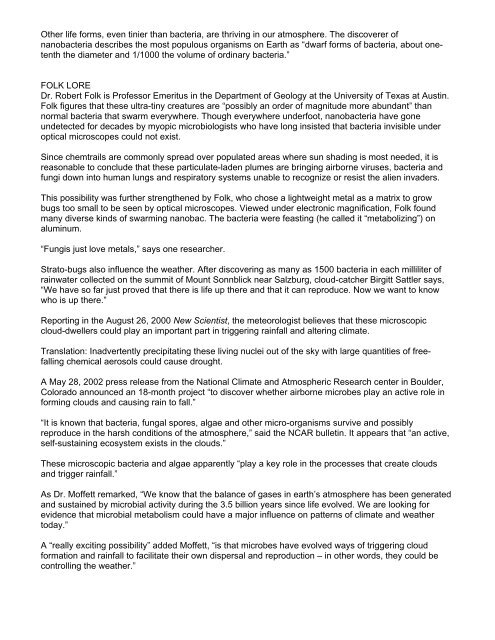CHEMTRAILS%20-%20CONFIRMED%20-%202010%20by%20William%20Thomas
CHEMTRAILS%20-%20CONFIRMED%20-%202010%20by%20William%20Thomas
CHEMTRAILS%20-%20CONFIRMED%20-%202010%20by%20William%20Thomas
Create successful ePaper yourself
Turn your PDF publications into a flip-book with our unique Google optimized e-Paper software.
Other life forms, even tinier than bacteria, are thriving in our atmosphere. The discoverer of<br />
nanobacteria describes the most populous organisms on Earth as “dwarf forms of bacteria, about onetenth<br />
the diameter and 1/1000 the volume of ordinary bacteria.”<br />
FOLK LORE<br />
Dr. Robert Folk is Professor Emeritus in the Department of Geology at the University of Texas at Austin.<br />
Folk figures that these ultra-tiny creatures are “possibly an order of magnitude more abundant” than<br />
normal bacteria that swarm everywhere. Though everywhere underfoot, nanobacteria have gone<br />
undetected for decades by myopic microbiologists who have long insisted that bacteria invisible under<br />
optical microscopes could not exist.<br />
Since chemtrails are commonly spread over populated areas where sun shading is most needed, it is<br />
reasonable to conclude that these particulate-laden plumes are bringing airborne viruses, bacteria and<br />
fungi down into human lungs and respiratory systems unable to recognize or resist the alien invaders.<br />
This possibility was further strengthened by Folk, who chose a lightweight metal as a matrix to grow<br />
bugs too small to be seen by optical microscopes. Viewed under electronic magnification, Folk found<br />
many diverse kinds of swarming nanobac. The bacteria were feasting (he called it “metabolizing”) on<br />
aluminum.<br />
“Fungis just love metals,” says one researcher.<br />
Strato-bugs also influence the weather. After discovering as many as 1500 bacteria in each milliliter of<br />
rainwater collected on the summit of Mount Sonnblick near Salzburg, cloud-catcher Birgitt Sattler says,<br />
“We have so far just proved that there is life up there and that it can reproduce. Now we want to know<br />
who is up there.”<br />
Reporting in the August 26, 2000 New Scientist, the meteorologist believes that these microscopic<br />
cloud-dwellers could play an important part in triggering rainfall and altering climate.<br />
Translation: Inadvertently precipitating these living nuclei out of the sky with large quantities of freefalling<br />
chemical aerosols could cause drought.<br />
A May 28, 2002 press release from the National Climate and Atmospheric Research center in Boulder,<br />
Colorado announced an 18-month project “to discover whether airborne microbes play an active role in<br />
forming clouds and causing rain to fall.”<br />
“It is known that bacteria, fungal spores, algae and other micro-organisms survive and possibly<br />
reproduce in the harsh conditions of the atmosphere,” said the NCAR bulletin. It appears that “an active,<br />
self-sustaining ecosystem exists in the clouds.”<br />
These microscopic bacteria and algae apparently “play a key role in the processes that create clouds<br />
and trigger rainfall.”<br />
As Dr. Moffett remarked, “We know that the balance of gases in earth’s atmosphere has been generated<br />
and sustained by microbial activity during the 3.5 billion years since life evolved. We are looking for<br />
evidence that microbial metabolism could have a major influence on patterns of climate and weather<br />
today.”<br />
A “really exciting possibility” added Moffett, “is that microbes have evolved ways of triggering cloud<br />
formation and rainfall to facilitate their own dispersal and reproduction – in other words, they could be<br />
controlling the weather.”


